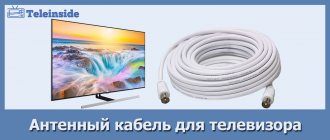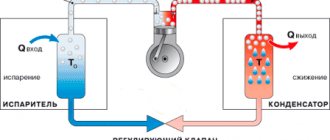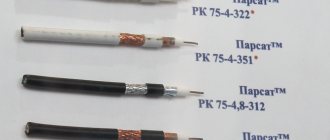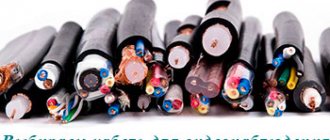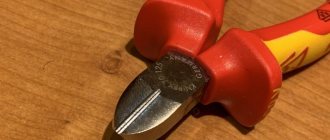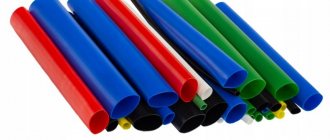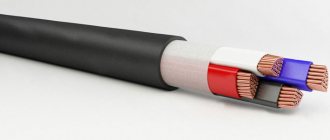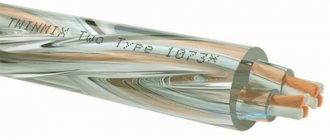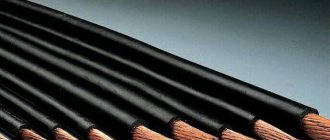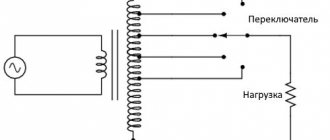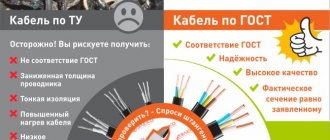In the process of choosing a television cable, you have to deal with a wide variety of offers, which even experienced specialists cannot evaluate. That is why, before purchasing the necessary coaxial cable for your TV, it is advisable to understand all the intricacies of its design and the main differences between the different brands of this product (they are shown in the figure below).
Types of coaxial cable products
From the variety of television (TV) cable samples offered on the market, we choose the only brand that is optimally suitable for this specific situation. How to choose the right coaxial cable without losing sight of even the smallest detail will be discussed in this review.
TV cable design
Coaxial cable device
The design of most cable television products is almost the same, since they include the following similar parts:
- The central core is in the form of a thin copper conductor;
- The dielectric sheath insulating this core is made of polyurethane;
- A layer of shielding foil;
- Additional screen based on steel (copper-plated) wire;
- PVC protective sheath.
Coaxial cable device
Note! Because of this design of television cable, it is sometimes called coaxial.
The central copper conductor is the main material medium that ensures the propagation of the television signal within the coaxial channel formed by the wires together with the shielding braid. Screen steel braiding is an excellent protection of the coaxial channel from electromagnetic interference and other parasitic interference.
The internal insulating sheath performs its assigned function, and the outer PVC coating protects the entire cable from mechanical deformation and damage.
Purpose and parameters of the main components
The central core of a cable product can have two designs, in one of which it is made of copper-plated steel wire, and in the second of pure copper. Copper conductor is used to transmit all types of television signals, as well as to power satellite TV converters via coax.
Additional Information. The cable for satellite television must also have only a copper central core (diameter is about one millimeter). In all other cases, copper-plated wire will do just fine.
At the same time, it is possible to save on material costs with a relatively high quality of signal transmission.
The reliability of the existing screen braid determines how efficiently a TV signal is transmitted via a coaxial line, as well as protection from interference from extraneous sources. Therefore, this part of the cable during its installation requires a special approach (in terms of cutting the braid and its reliable fixation).
Aluminum foil (lavsan) is used to make screen film, and the braid itself can be made on the basis of copper or tinned wire (sometimes the same aluminum is used for its manufacture). Choosing the right television cable with this design means ensuring a high shielding coefficient (about 60-80 dB, and in some cases up to 90 dB).
The polyethylene (PE) dielectric present in the internal part reliably protects the central core and at the same time insulates it from unwanted contact with the screen and outer braid. The outer PVC sheath, in addition to reliable protection against deformation, protects the cord from moisture, dust and strong temperature changes (when laid outside buildings and on strings).
Important parameters
When choosing a coaxial cable, you need to consider a number of parameters:
Temperature resistance
Before choosing a cable, you need to consider where the cable will run. If the antenna will be placed somewhere behind the house or on its roof, then preference should be given to a cable that is resistant to temperature changes. The resistance of the wire to high moisture is also important. It is best to use a thick cable with a thicker central core for street wiring. Such a cable must be framed in dense top insulation.
Diameter
- To place the antenna on a window or balcony, a cable with an outer diameter of 6-8 millimeters will be sufficient.
- For street wiring, a thicker cable is suitable - 10 millimeters in diameter or more.
- If we proceed from durability indicators, then it is better to immediately purchase a thick television wire.
Braid density
The density of the cable is an indicator of its long service life, but during installation sometimes you have to bend the wire in several places, so you should not take a cable with the most rigid insulation. A conductor in thin rubber, aluminum film or polyethylene dielectric, PVC is ideal. Good braiding should not be easily peeled or pulled off the wire, and it will not be easily scratched.
Copper core
The priority is for cables with a copper core. There is no evidence that other alloys are worse or unreliable, but according to the advice of electricians, it is better to buy a copper product.
There are also copper-plated steel conductors, most often their production is based in China, you should not be afraid of this, the service life of such wires is in no way inferior to copper ones.
Good composition
You can determine the composition of a coaxial television cable by asking the seller to make a cut on the wire. Ideally, in a cross-section, the buyer should view a copper core with a cross-section of at least 1 millimeter in diameter, dense insulation, a layer of dense foil and braiding made of copper or tin, a screen made of aluminum or copper wire, and a dense outer shell made of PVC foam polyethylene.
Length of cable
This indicator should be purely individual. Before purchasing, you need to measure the distance from the TV to the proposed antenna. This distance should include all possible turns, notches and bends. The wire should not be close to both installations, it should not be stretched; a minimum reserve is required in case of reinstallation or stripping.
Cable accessories
When purchasing a cable, you must immediately buy splitters, connectors, plugs and adapters. Before purchasing, ask the seller to try them on the selected wire so that they fit exactly in diameter. Ideally, you should immediately stock up on corner adapters so that the bending of the coaxial cable is minimal.
Brands and characteristics
How to connect a TV cable
If you want to decide which television cable is better, you should proceed from the fact that this product can be produced in various designs. The main ones are the following brands:
- SAT 50, 703;
- RG 6, 59;
- as well as DG 113 and traditional RK 75.
Cable RK-75
The listed products for cable television have a characteristic impedance of 75 Ohms and can be used to connect several televisions at once. Let's look at each of them in more detail.
Cable RK 75
This type of cable product is traditionally produced in Russia and has a long history dating back to Soviet times. It contains the same central core of pure copper (diameter - 1 mm), around which a PE dielectric is located.
On top of this structure there is a shielding braid made from thin copper wire or from a double layer of aluminum lavsan (foil and braid). A cable with a single-layer protective shielding is usually used in terrestrial and cable TV systems.
Products with double screen protection can also be used for digital TV systems, and they are usually installed in the interior spaces of buildings.
RG-6 cable
This cable is a Russian brand, but it is produced in China. Its central core is made of copper or copper-plated steel wire of millimeter thickness in a protective sheath of polyethylene. The total thickness of the wire together with the insulating layer, braiding and protective sheath is approximately 6-6.8 mm (see figure).
RG-6 cable
Most often this type of wire is used in cable or regular television broadcasting, but it is sometimes used for digital television. Cable products of this class are among the cheapest types of products that have a very reasonable price.
Cable RG 59 (modification of cable RG-6)
This type of RG-6 cable has a thinner central core (diameter - 0.5-0.58 mm) and an outer size of about 6.0 mm. It is ideal for transmitting various types of data, including satellite signals transmitted over distances of up to 190 meters.
Important! Due to the low conductivity of the relatively thin central conductor, the signal attenuation in such a cable increases by half (see figure below).
Coaxial cable RG-59
The high level of loss in RG 59 results in image quality deterioration that increases with each additional meter. This sample cable product can only be used for one receiver.
Its disadvantages are associated with the installation features of a thin conductor, which is fixed with great difficulty in the coaxial connector and often breaks off if handled carelessly. In addition, large attenuation in a thin core greatly weakens the signal in series circuits.
Cables SAT 50, 703 and DG 113
The manufacturer of these two types of cable products is Italian. The first of these wires has a copper central core 1.0 mm thick, as well as a reinforced screen made of foil and copper-tin braid.
SAT 50 cable
The shielding coefficient is more than 60 dB.
PEG dielectric is used as the inner insulating shell, and the outer protective coating is made of PVC. The total diameter of this cable product is 6.6 mm, and its price per meter is slightly higher than other samples. SAT 50 is capable of transmitting all types of television signals and can work as part of cable, digital and satellite equipment.
The SAT 703 product has a slightly thicker central core (1.13 mm), its screen is designed in the same way as in the previous case. The difference is the overall cable thickness of 6.6 mm and the shielding factor of about 80 dB. This cable has good transmission characteristics and can be used in any TV systems, including satellite channels.
The DG 113 brand cable is produced by the same manufacturer, but, unlike the two models discussed, it has a higher shielding coefficient (from 90 dB). It provides the highest broadcast quality with virtually no interference. However, the cost of one meter of this product, most often used for satellite dishes, is one of the highest.
How does a television cable work?
Analyzing the structural features, it is possible to say with a high probability that absolutely all models have approximately the same concept of internal structure:
- The inner conductor is made of solid wire, copper tubing, or multi-strand material. The quality of the material determines the signal reception distance, as well as the permissible bending indicator.
- The dielectric layer acts as a conductor clamp.
- The external conductor is braided. Often made of foil and thin wire. Quality affects the level of protection against external factors, such as electromagnetic interference.
- The inner sheath provides protection for absolutely all structural elements of the cable.
Thus, the types of television cables differ little in structure. Of course, there are certain features, but mainly they manifest themselves in the quality of the material from which this or that element is made.
Which TV cable is better to choose? The answer to this question directly depends on your goals. For example, if the signal distance is minimal, then there is no point in overpaying for an expensive coaxial cable conductor. In general, television cables and their varieties are universal, as they are suitable for satellite, digital and analogue broadcasting.
Which cable is better
If you want to find an answer to the rhetorical question about which television cable is better, you need to proceed from the following considerations.
Which cordless screwdriver is better?
For satellite TV, preference in all cases should be given to Italian products (despite the relatively high cost).
The opinion of experts, who believe that it is pointless to choose a separate cable for each of these cases, will help you decide which cable is needed for simple, digital and cable television.
Additional Information. The fact is that the frequency channels for all of the listed types of broadcasting are practically no different from one another and fit in a limited range from 49 to 800 MHz.
This frequency gap can be covered by using any of the previously discussed types of cable products. If problems arise with what is better to choose: the Italian branded wire of the “Cavel” brand or the budget option RK-75, you should proceed only from financial capabilities. All intermediate cable product offerings should be considered transitional between the two extremes.
To summarize the material discussed in this review, we note that even taking into account all that has been said, for digital or cable television it would be much preferable to use any product from the “Cavel” family. Despite the fairly high cost of these cables, they can be used to provide high-quality broadcasts of any television sources and programs.
Coaxial cable installation guidelines
In order to protect yourself from most problems when laying this type of cable, you must adhere to the following rules:
- Avoid laying wires parallel to the power ones and do not place them closer than 30 cm to each other. Noise from the electrical network may take the form of several horizontal stripes on the monitor screen that slowly move down (or rise up);
- Avoid loops and bends in the cable during installation, as they disrupt its uniformity, which can lead to the loss of small parts of the picture or doubling of the image. The image quality will be better if the loop bend is at least 5 times the diameter of the coaxial cable. During operation, the central wire may break off at a bend, which will lead to a complete loss of the video signal;
- Use only a single piece of cable and under no circumstances use so-called “twists”;
- To reliably connect video system components, it is recommended to use special BNC connectors, and leave a sufficient supply of cable in places of future connections.
BNC connectors
In video surveillance, special connectors are widely used to connect coaxial cable to cameras, DVRs, or connect two cables to each other. The most common are BNC connectors. They come in three types - crimped, soldered and threaded.
The experience of many installers has shown that crimp connectors are the most reliable. Their connection order is as follows:
- Carefully cut the outer layer of cable insulation with a sharp knife - about 20-30 mm from the end;
- Place the metal sleeve over the insulation;
- Bend the braid (screen) back towards the insulation;
- Cut off the translucent plastic of the dielectric, in the center of which the signal core is located;
- Place a BNC connector onto the copper core. The “screen” braid is evenly applied over the connector;
- We move the metal sleeve to the end of the wire so that the braid is underneath it. The coupling is fixed to the connector using a special tool (it is not recommended to use pliers for this). The BNC connector is ready to be connected to the recorder.
We will tell you more about this type of connector in the next article.
Choosing the best antenna cable for your TV
Modern television broadcasting will reveal its potential only if a good antenna cable is used. Manufacturers offer many cable models with different technical characteristics. Despite the similarity of internal design, the products differ in materials of manufacture, conductor cross-section, and other features. Let's figure out what parameters to pay attention to in order to watch TV shows and movies with pleasure.
Let's sum it up
Coaxial cable is one of the most important elements of antenna installations. This fact is often underestimated when purchasing a cable at the lowest price or based on convenience.
So, if you don’t know which television wire to choose, it’s better to choose one that meets the following criteria:
When choosing an antenna cable, do not be guided by the fact that the inner core and braid must be made entirely of copper, and also do not chase the “Premium” stamp and do not buy a special “digital” cable. No such cable exists. The wide range of modern products includes frequencies of both digital and satellite TV.
Source
If necessary to lengthen
There are situations when it is necessary to make an extension cord for the antenna cable, in which case you will need an adapter or socket to which the connectors are connected (male-male for the adapter and male for the socket). The extension connector will allow you to extend the conductor to the required length and provide a reliable connection without loss of signal level.
Photo of adapter and socket
Connecting multiple TVs.
The realities of our time are such that for a home one TV is more the exception than the norm. You can connect several devices to a plug with an antenna cable connected to it, all you need to do is install splitters.
Photo of a splitter for connecting two TVs
You can buy such a device or make it yourself; in the latter case, you can be sure that it will not create interference, unlike products assembled by Chinese comrades.
A simple, but at the same time reliable circuit for simultaneously connecting several TVs is shown in the figure.
Splitter circuit
The most important thing for the correct operation of the splitter is to calculate the resistances (they must be of the same value), the formula for this is as follows :
R – resistor resistance (Ohm);
Z – value of cable impedance (Ohm);
N – number of connected devices.
In our case, when connecting two TVs, the calculation will be as follows:
It should be noted that when connecting more than three devices to such a circuit, you will need to insert an antenna amplifier, since there will be a significant loss of signal level.
What is important when choosing
The choice of cable for a TV antenna is based on 7 main factors:
- Outer shell material. In the production of feeders, two options are used - PVC and light-stabilized (that is, resistant to ultraviolet rays) polyethylene. PVC is ideal for use inside an apartment (for example, when connecting to a communal antenna or cable TV). But for external laying nothing better than polyethylene has yet been invented. An unsuitable type of coating will lead to cable damage and breakdown.
- Strength of the outer layer. It is enough to try the outer PE or PVC sheath on a section of the feeder by pulling it towards you. If it moves easily, there is no need to use the cable: bending may damage the screen.
- The length of the route along which the cable channel will pass. The longer, the greater the loss of signal power due to conductor resistance. Therefore, where you need to lay a long route (10 m or more), it is better to use a cable with a copper central core rather than a steel one;
- Incoming signal power. Reception of terrestrial relay television broadcasts of the DVB-T2 standard provides the equipment with sufficiently powerful impulses, the same applies to cable TV. But the signal strength coming from the satellite is low. Therefore, for dishes it is better to choose cables with a copper core.
- Diameter of the central core. The thicker it is, the less loss during signal transmission. However, conductors that are too thick may require special adapters in order to be used in standard connectors.
- Cable thickness. Typically, the more powerful the feeder, the more layers of shielding are used, the thicker the central core and the more reliable the insulation. However, this is only an indicative sign. A high-quality, thin cord may be better suited for installation than a thick, low-quality cord. We'll talk about this below.
- Material of the central core. Copper transmits the signal better, clad steel is stronger. It’s easy to check what the core is made of: you need to take a magnet and bring it to the cable. If there is attraction, it means steel, if there is no attraction, it means copper.
Additionally, you can look for the following signs:
- Reviews of specific brands. It’s better to look at TV master forums rather than in online stores: there’s a greater chance that a particular review was not paid for, but was compiled on the basis of practical experience.
- Manufacturer. There are several brands whose products have no complaints (for example, the Italian company Cavel). For others, you need to look at the parameters of a specific brand.
